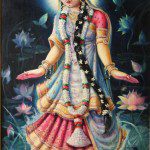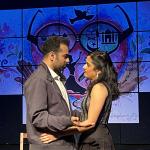When I was in India I bought a copy of this book about the 16 major life rituals.
Previously I talked about the first samskar, garbhadhana and today I want to look at the second samskar: Punswan.
This one is performed three months after conception. Though some believe it to be a way to get a male child, this author insists that it is actually calling the life force to enter the womb. It is supposed to help the fetus become physically and mentally balanced. The author says it is very important for the mental growth of the child.
At this time it is also mentioned that a woman who leads a sincere and pious life during pregnancy will get a bright child. There are some precautions given for the pregnant woman, including that she should avoid being sad. The husband has rules as well. During the pregnancy he should not go on a long journey, take part in funerals, cut his hair or nails, participate in war, or get a new house constructed.
This ritual can be performed during any auspicious day in the third month of pregnancy.
First the punswan itself is prepared. This is a concoction of equal parts juice of the rootlets of Nyagrodha banyan tree, banyan, bramni buti, somalata, and giloya. It is ground into paste and passed through a muslin cloth. Kheer is also prepared .
The following two mantras are said over the punswan:
Aum hiranyagarbhah samwartatagre bhutasya jatah patireka aasit.
Sadaadhaara prithvi dyaamuteshaam karmai devaaya havishaa vidhema.
Aum adabhyah sambhritah prithvyai rasaachcha
viswakarmanah samwartatagre
Tasya twastaa vidadhadrapameti taamatyarsya devatwam aajaanamagre
Then the Shodashmaatrikaa pooja and homa is performed. I don’t know what a shodashmatrika puja is, unfortunately and the only clue Google is giving me is that it may be related to Lakshmi.
After that the woman cups her hands around her knees and on her right hand curd from the milk of a cow with a he-calf is placed, along with a cob of barley with its head facing east and two black grams (?) to symbolize male sex organs. The woman should say: Punswan grihityaami (I’m taking the punswan) and eat the curd. Then she drinks clean water from her right palm. This is repeated twice.
Then the punswan mixture is poured in the woman’s left nostril by her husband. The two mantras are recited again.
Water with a coconut in an earthen plate is put below the navel of the woman. Her husband touches her abdomen with the tip of his ring finger and recites the Aum Suparnoasi Mantra:
Aum suparnoasi gurutwaama stribrite shirogaatram chakshur brihadarath antare pakshau. Stoma aatmaa chandang syamaani yaju ang shi naama. Saama te tanurwaamadevyam yagyaayaygiyam puchcham dhishnayaah shaphaah. Suparnoasi gurutmaan divam gachchha swah pata.
The kheer prepared earlier is offered to the fire. Five times it is spooned into the fire and each time this mantra is said:
Aum dhaataa dadhaatu dashushe praachi jeevaatumakshitaam. Vayam devasya dheemahi sumati waajiniwatah swaahaah. Idam dhaatre na mam.
The woman’s husband then holds a part of kheer covered with a utensil and a flower over the woman’s head while chanting:
Aum payah prithvivyaam payah aushadhishu payo divyantikshe payo dhaa payaswatih pradishah santu mahyam.
Then the husband places his right palm ont he head of his wife and chants the following:
Aum yatte suseeme dridaye hitawantah prajaapatau. Manye aham maam tadwidwaam samaaham pautraamadyanniyaam.
At the end of the ritual all the elders present give blessings. The woman then eats the kheer at the start of her next meal.
***
The author mentions that this ritual is dying out and the chapter ends with a warning that modern technologies should not be used to the purpose of aborting female children.
















